Environmental Professional’s Guide to Lean and Six Sigma: Chapter 4
How Do Lean and Six Sigma Relate to the Environment?
- How Lean Improves Environmental Performance
- Environmental Benefits Arise From Eliminating Lean Wastes
- Environmental “Blind Spots” of Lean
- Lean’s Relationship with Regulatory and Permitting Requirements
- How Lean Compares to Environmental Initiatives
- Where to Find More Information on How Lean Relates to the Environment
- Toolkit Navigation
How Lean Improves Environmental Performance
Research has found that Lean methods improve environmental performance, even without intentionally adding environmental considerations. Some examples of these environmental benefits are listed in Box 11. Considerable environmental gains often “ride the coattails” of Lean implementation. There are two main reasons why this occurs:
- Environmental impacts are embedded within the wastes that Lean targets.
- Lean produces an organizational culture that is highly conducive to waste minimization, pollution prevention, environmental management systems, and sustainability.
Environmental Benefits Arise From Eliminating Lean Wastes

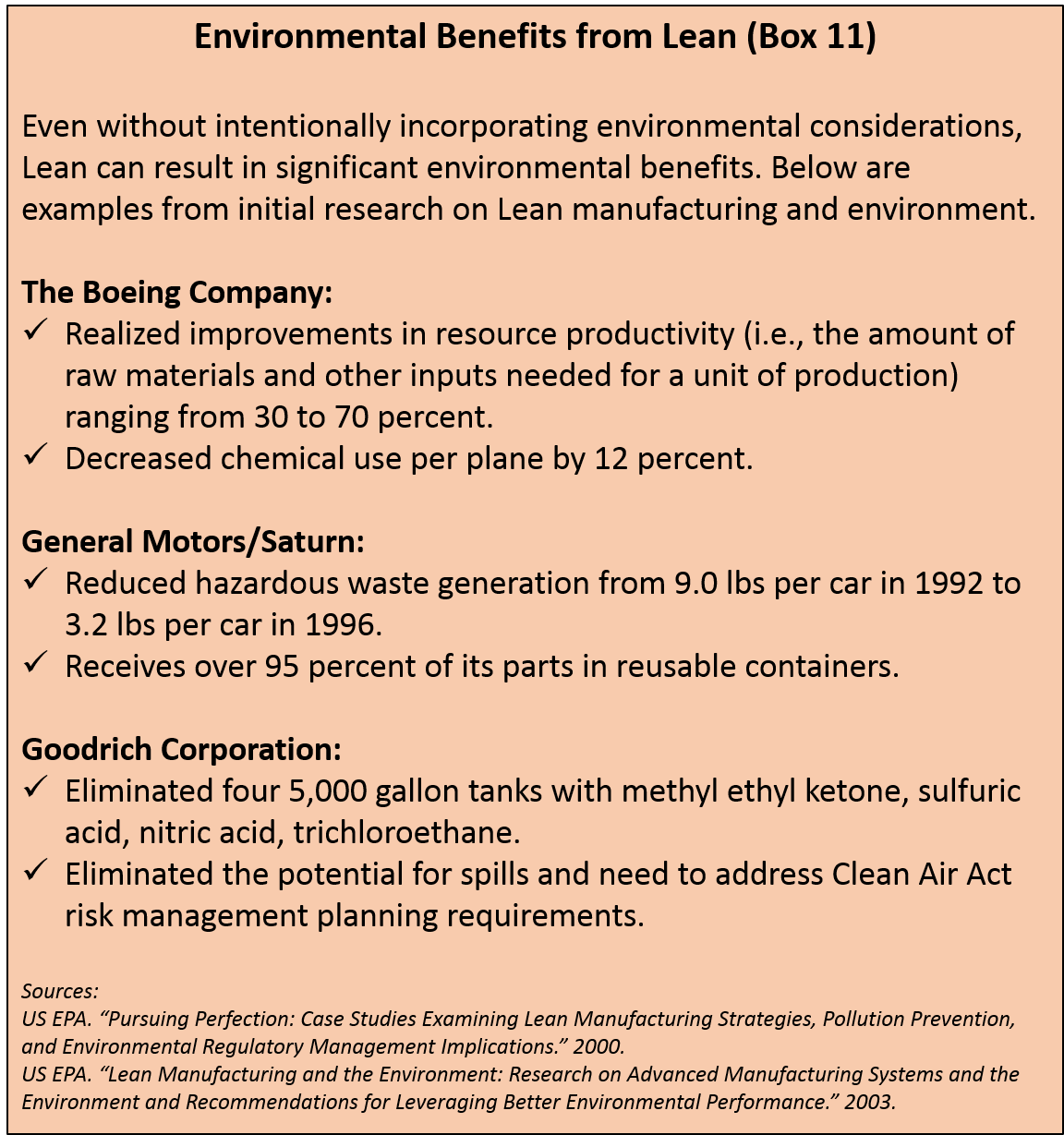
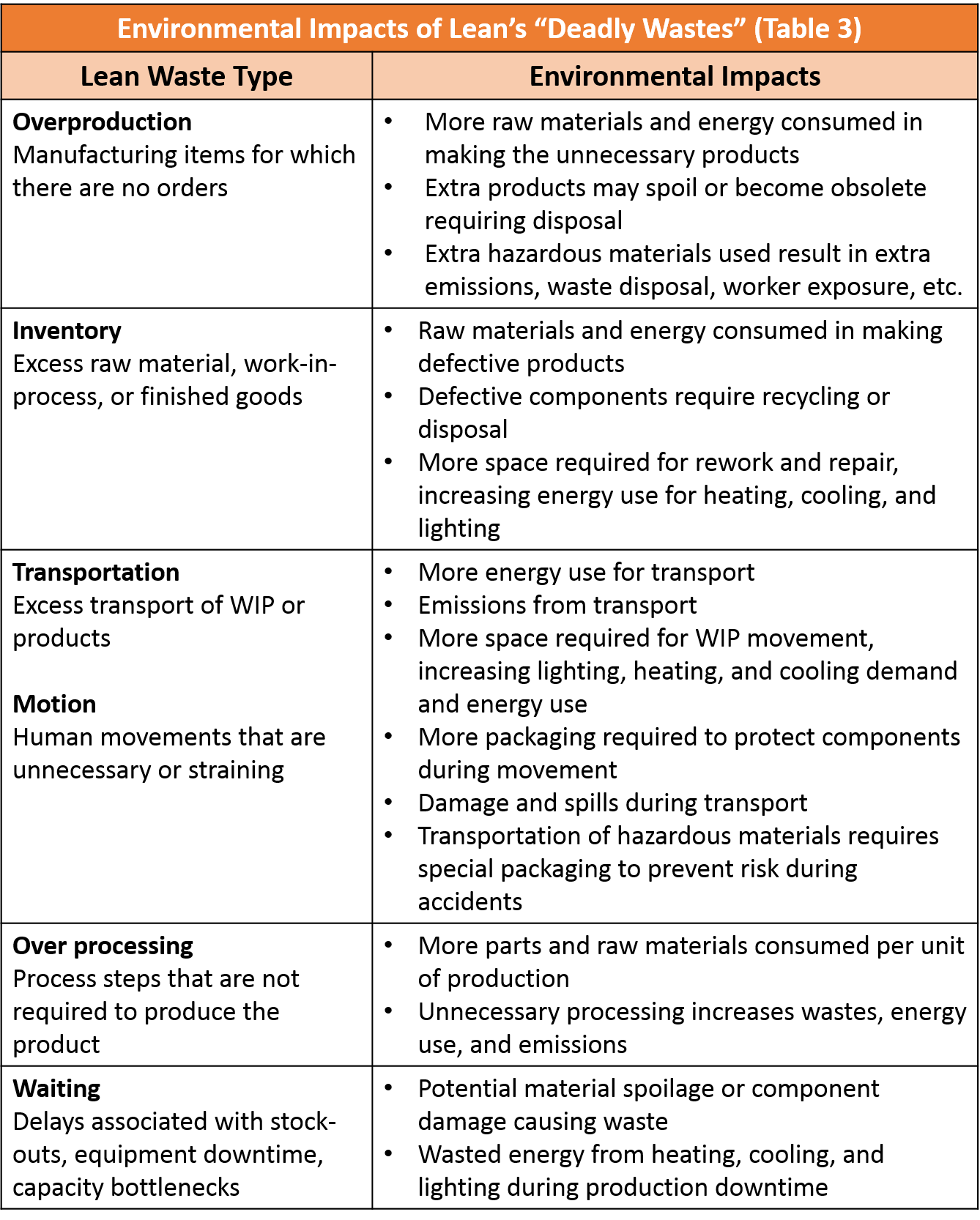
Environmental Benefits as a Result of Culture Change

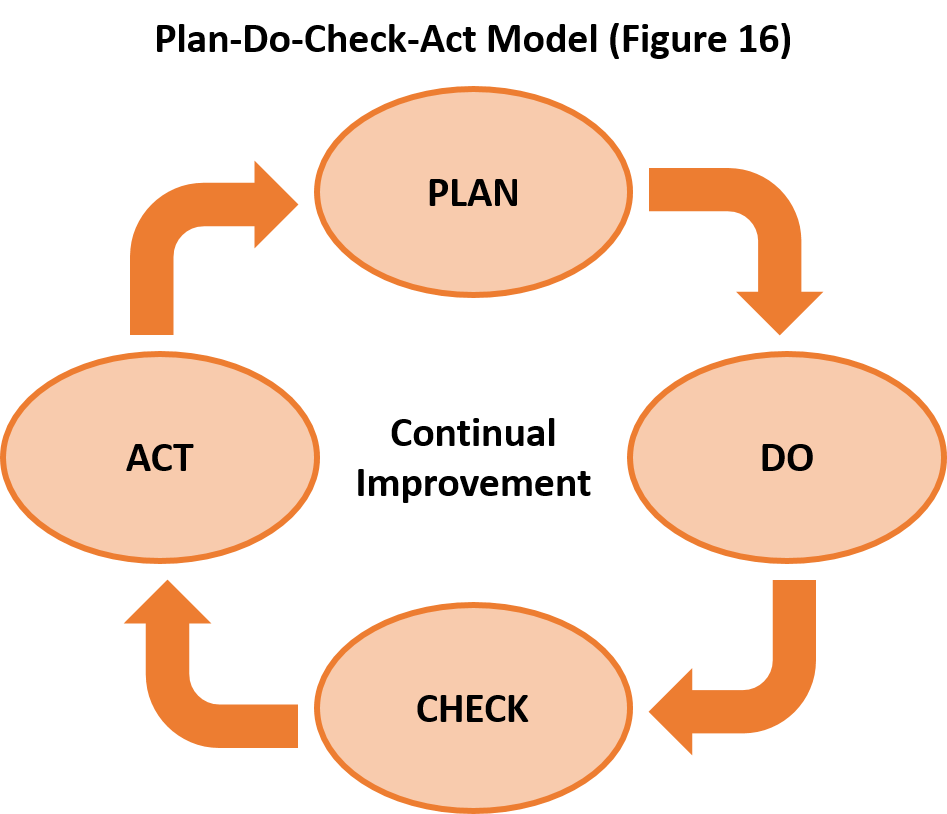
Environmental Blind Spots of Lean
Despite the considerable environmental performance gains that result from Lean implementation, there are a few environmental “blind spots” that Lean methods, on their own, do not typically address.

Environmental professionals can help Lean practitioners understand the costs associated with environmental wastes and that these costs do not have to be considered “necessary” if the process or product can be changed to generate less of a particular waste. Box 12 is an example of how environmental professionals can help Lean teams see blind spots.
There are three mechanisms by which these blind spots occur.
- Lean methods do not explicitly identify pollution and environmental risk as “wastes” to target for elimination. Lean implementers often think of waste somewhat differently from the way environmental agencies think of waste. Lean’s “deadly wastes” do not explicitly include wastes that are targeted by environmental management activities, such as solid and hazardous waste, air emissions, and wastewater discharges; nor is resource consumption, such as use of materials, energy, and water, directly targeted.
- Environmental practitioners are not always well-integrated into operations-based Lean efforts. Often environmental management activities operate in a “parallel universe” to Lean implementation efforts. This appears to be particularly true in the early stages of Lean implementation, when environmental managers may not be familiar with the methods being adopted by their organization. The involvement of environmental practitioners in Lean implementation efforts can both reduce the risk of non-compliance with environmental regulations and increase opportunities for realizing more environmental benefits.
- The expertise related to waste minimization and pollution prevention is not routinely making it to Lean practitioners. Environmental agencies and non-profit organizations promoting P2 and waste minimization have developed numerous tools and compiled many specific actions that organizations can take to improve the resource productivity and environmental performance of processes.

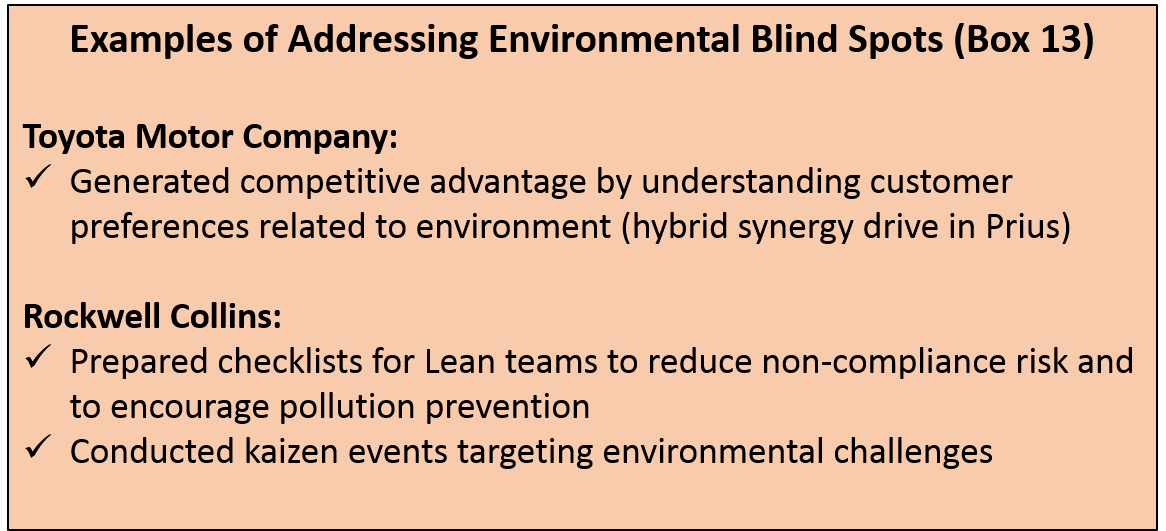
Lean’s Relationship to Regulatory and Permitting Requirements

Such issues most frequently arise around environmentally sensitive manufacturing processes. These processes typically involve hazardous chemicals that have the potential to adversely affect worker health or be released to air, water, or land. Examples of environmentally sensitive processes include:
- Chemical point-of-use management
- Chemical treatment
- Metal finishing processes
- Painting and coating
- Parts cleaning and degreasing
Lack of regulatory precedent or clarity can cause even the most well meaning companies to misinterpret requirements and experience violations, even where environmental improvement has resulted.
One area in which rapid, frequent changes may trigger environmental requirements is air permitting, such as those in the New Source Review provisions of the Clean Air Act. Even if an operational change only has the potential to alter air emissions at a facility, a permitting action may be required. If changes are made without authorization by an environmental agency, a facility can face stiff penalties. If a permitting action is required, permitting timeframes of several weeks or months can severely impede Lean implementation progress. EHS staff can help to minimize these delays by working with their air permitting authorities. In addition, EPA, in collaboration with State and local permitting authorities, have developed innovative air permitting approaches that can accommodate significant operational flexibility while addressing applicable air requirements and protecting the environment (see Box 14).

How Lean Compares to Environmental Initiatives

Lean and environmental initiatives are rooted in a common heritage and have strong similarities. As discussed earlier in this chapter, Lean and leading environmental initiatives, such as P2 and EMS, are all based on Edward Deming’s Plan-Do-Check-Act framework and a philosophy of continual improvement. Lean and environmental initiatives focus on eliminating waste, although there are differences in the scope of how “waste” is defined. In addition, Lean and environmental initiatives seek to foster an organizational culture that emphasizes employee involvement in problem solving.
In summary, Lean and environmental initiative activities seek to:
- Foster a systematic approach to continual improvement
- Implement systematic and ongoing efforts to identify and eliminate waste
- Engage employees actively in improvement activities
- Emphasize the importance of using metrics to inform decisions
- Engage with the supply chain to improve enterprise-wide performance
While the common heritage and similarities are strong, Lean has fundamental differences from environmental initiative approaches, as follows:
- Drivers: Lean’s drivers are deeply rooted in business competitiveness, capital productivity, and customer satisfaction. Lean is often implemented as an organization’s dominant operational strategy to respond to or prevent crises that may threaten an organization’s survival. While environmental initiatives can make important contributions to operational efficiency, the bottom line, and even the top line, the magnitude of benefits from environmental initiatives is often significantly less than those associated with Lean.
- Methods and Tools: While some Lean and environmental methods are similar, there are often important differences. For example, Lean value stream mapping and the process mapping techniques commonly used in P2 efforts both visually represent processes, but they have distinct differences in the type and format of information displayed.
- Definitions of “Waste”: While definitions of “waste” overlap somewhat, Lean’s seven “deadly wastes” do not explicitly encompass all types of environmental wastes.
- Language: Lean practitioners and environmental professionals have distinct terms, lexicons, and language for describing their work. Without proper translation, language differences can pose barriers to collaboration.
- Organizational Champions: Lean is typically driven by senior operations or business managers, while environmental initiative efforts are typically led by EHS personnel. Lean and environmental champions often have very different access to information and resource and influence over organizational decisions and investments.

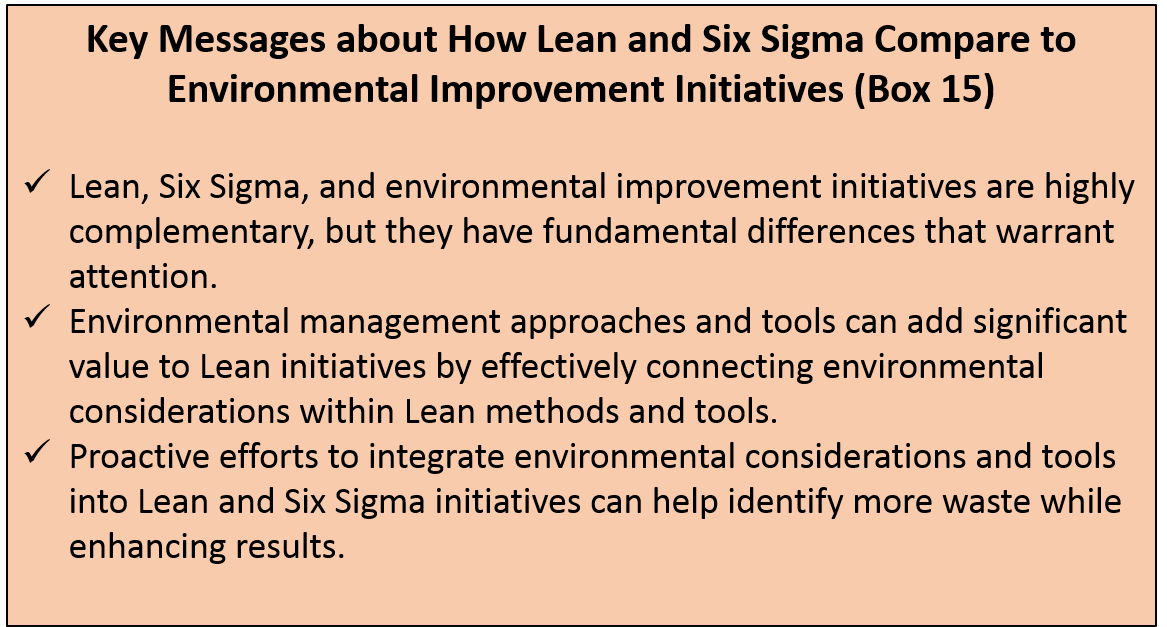
Where to Find More Information on How Lean Relates to the Environment
The relationship of Lean to environmental performance and the environmental regulatory framework is discussed in detail in EPA’s Shingo Prize winning 2003 report, "Lean Manufacturing and the Environment: Research on Advanced Manufacturing Systems and the Environment and Recommendations for Leveraging Better Environmental Performance." Appendix B of this guide also lists tools, case studies, and other publications about Lean, Six Sigma, and the environment.
By integrating environmental considerations into Lean, organizations can overcome blind spots, pro-actively address any regulatory friction, and generate even better environmental results. The following chapters provide information on how to talk about Lean and environmental initiatives and how to get started with Lean and environment.
Toolkit Navigation
- Contents & Acknowledgements
- Executive Summary
- Chapter 1: Why Lean and Six Sigma Are Important to the Environment
- Chapter 2: What Is Lean?
- Chapter 3: What Is Six Sigma?
- Chapter 4: How Do Lean and Six Sigma Relate to the Environment?
- Chapter 5: Why Does It Matter How We Talk About Lean and Environment?
- Chapter 6: Lean and Environment Applications
- Chapter 7: Conclusion
- Appendix A: Lean and Six Sigma Resources
- Appendix B: Lean and Environment Resources
- Appendix C: Lean and Six Sigma Glossary
- Appendix D: Environmental Glossary
- Appendix E: Summary of the Washington Lean and Environment Pilot Projects
